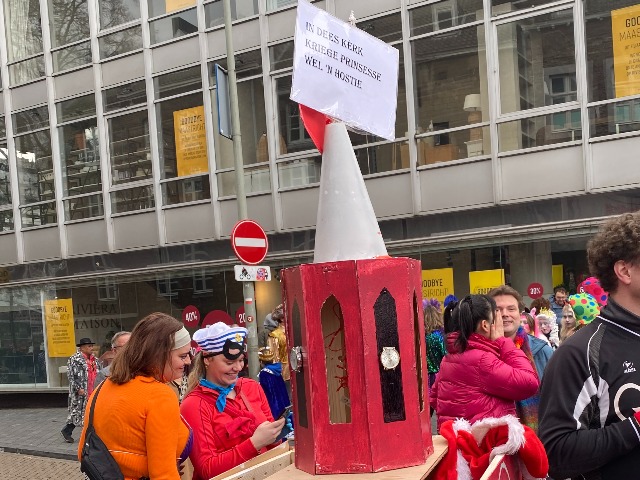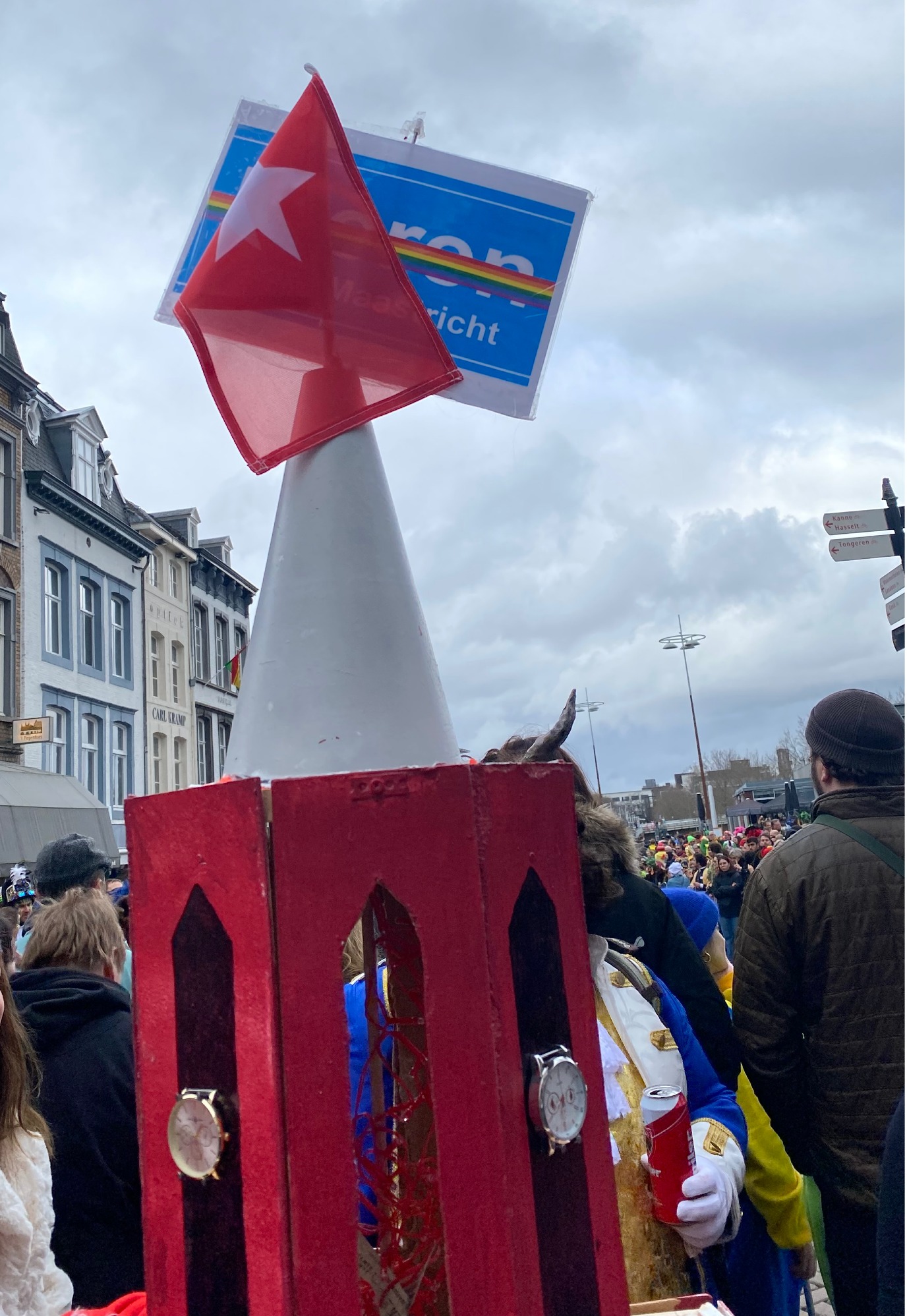Once upon a time, there was a princess and a priest...

Last Sunday, I went into the centre of the town of Maastricht with my family to celebrate Carnaval and watch the ‘Bonte Storm’ (the colourful storm, as big parade on Sunday is called). We walked slowly, often stopping to admire a group with particularly creative outfits and small carts that they had fashioned for themselves to bring along their beer and other refreshments. These creations are often at least as interesting as the costumes themselves, and real works of art. We stayed for a while talking to two men, one of whom let us play on his drums on his cart, the other dressed in a red boilersuit covered with heart shaped sponges. Closer to the parade, we bumped into a small group who had a costume that was made to look like a church, in red (like one of the big churches in Maastricht), with a sign on top saying, in dialect: in this church two princesses can receive communion. On the back, the placename of Itteren was combined with a rainbow flag (see pictures).

One of the delights of Carnaval is the tongue in cheek commenting on current affairs. So what is the back story here?
Princess Carnaval
Last week, several news media in the Netherlands carried a story about a village association, de Vreigeleire, that had decided to boycott mass. The Vreigeleire means the whiners, complainers. Traditionally, Carnaval lasts three days, and officially starts on Sunday after mass with a big parade that people work on for months. It’s an important tradition in the south of the Netherlands, in the provinces of Brabant and Limburg (or below the rivers, as we call it in the Netherlands). This is also the region that has historically been Catholic majority, something that still makes a big difference culturally, even though one wouldn’t find many people attending church on a Sunday, many value this Catholic identity highly; it connects them to their locality.
In Limburg, where Maastricht is located, each village has its own Carnaval association, and bigger cities such as Maastricht have several. Most have names that make fun of themselves. Making fun of yourself and others is basically what Carnaval is about. The Carnaval I know, of Maastricht and environs, is a party for everyone: at night, young and old go partying and consume large quantities of beer, dance with each other while often not being sure who you are dancing with because of the costumes, face paint and masks. During the day people go around in small groups, sometimes as a family, dancing and making noise and singing along to whatever music is being played nearby. It’s fun, and it can be done lightly, or extremely. Some of my classmates in high school used to save up for a year and go out three days in a row, spending hundreds, others just go into town on Sunday to watch the parade.
Preparations start early: on the 11th of November, the associations choose their ‘prince Carnaval’ who leads the festivities and has all kinds of ceremonial functions, wearing the traditional Carnaval jester’s hat. This year, in the village of Itteren (just 4 kilometres from the village where I grew up), they chose a princess Carnaval (and why not?), who happened to be in a relationship with a woman.

…. And the priest
The local priest, therefore, went to their house and explained to them how he envisaged the mass would go: they could come forward for communion along with the rest of the village during mass, but he instructed them to stand before him with their arms crossed so it would be clear that they would not receive communion. Basically, he was giving them a script so that he could gracefully refuse them communion for their ‘sinful’ lifestyle.
However, the two women refused to cooperate, and asked him (in a friendly way, it is said) to leave their house. After which the rest of the Vreigeleirs also decided to boycott mass. The priest is sad about it, he doesn’t like to hurt people, but saw no other way. Since this priest also serves the village where I grew up, the Carnaval association of that village also decided they would not attend mass. They are called the Beerbieters (beer biters). As they put it: we know our friends in Itteren, so we support them.
The little group with their church creation offering communion to princesses were commenting on these events. Their costume, and the news stories about these events, show something that is in a way traditional about the relationship between Carnaval and the Catholic church, which has always been fraught. It’s a three-day party, after all, with lots of licentious behaviour. Although Carnaval has been celebrated for centuries, the church has often tried to suppress or at least regulate it. Even mid-twentieth century, there are stories about villagers having to beg permission from the local priest to use a field for a Carnaval celebration. However, with the emptying of the churches since the late 1960s, Carnaval has grown into a ever more popular and creative yearly celebration. Since it is linked to the ritual calendar of the Catholic church (it ends on Ash Wednesday), the church continues to play a role, sometimes willingly, sometimes with attempts to regulate, as in this case.

Faith in the familiar
In my book ‘Faith in the familiar’ I described how this ambivalent relationship between the people of Limburg and the Catholic church has evolved since the 1960s, when there was first a wave of liberalization and then, starting with the appointment of the surprise appointment of bishop Gijsen in 1972, an ever widening distancing between parish church and village life. The sacraments played a crucial role in this: the priests appointed by Gijsen followed the line that they should be used discriminatingly. During the research for this book, I heard many heart wrenching stories about this: people on their deathbed being told they could not get the last sacraments because they were divorced, a funeral mass of an 18year old where almost no one could come forward because they were not ‘sexually pure’. They were part of a genre of ‘bad priest’ stories, where people constructed an alternative moral universe with the priest as the villain.
Terra incognita.
What happened in Itteren is different: the priestly attempt to control who receives the sacraments did not result in a heart wrenching story. It resulted in two women who clearly told the priest to leave their house, and two village associations who calmly support them. And of course, a great carnaval story, sparking creative fun and statements. Another moral universe became visible in these seemingly sleepy villages, operating on the principle of inclusivity and solidarity. Terra incognita apparently for this conservative moralizing priest and the bishop who supports him, but no less real.

